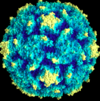Lecture 4 Flashcards
What provides the basis for viral assembly?
Viral symmetry
What are the two rules of viral symmetry?
- Each subunit makes identical contacts with neighbouring subunits
- Bonds between subunits are non-covalent (weaker) interactions
What virus has helical symmetry?
The tobacco mosaic virus
What virus has polyhedral symmetry?
Simoan
For polyhedral viruses to maintain round symmetry despite irregular protein shapes, they must have a defined number of proteins. What numbers are possible?
60, 180, 240, 960
In an icosahedron, where are the axes of symmetry?

Vertice: 5-fold symmetry
Face of trimer: 3-fold symmetry
Edge: 2-fold symmetry
How many subunits are there in the Norwalk virus? Why isn’t it a perfectly symmetrical icosahedron?
180, it is a quasiequivalent icosahedron, which means that it tends to begin to lost the 5-fold axis of symmetry as some trimers form 6-fold vertices.
What method was used to obtain this image?

Cryo electron microscopy
How was this image obtained?

Through the use of NMR spectroscopy
How was this image obtained?

Electron microscopy
How was this image obtained?

X-ray crystallography
How was this image obtained?

Cryo EM


